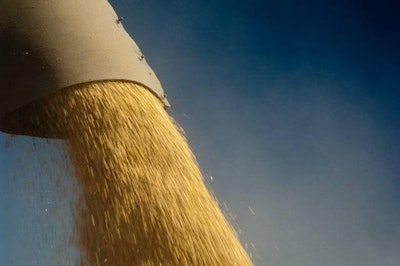
This article appears in the June issue of Feed International. View all of the articles in the digital edition of this magazine.
The U.S. Soy Sustainability Assurance Protocol (SSAP) is the most recent responsible soy program to meet the European Union feed industry’s baseline criteria. Since the European Compound Feed Manufacturers’ Federation (FEFAC) released its Soy Sourcing Guidelines in September 2015, nine responsible soy programs have looked into the recommendations and have met the criteria through the accompanying International Trade Centre (ITC) benchmarking tool.
The benchmarking tool shows at what level responsible soy programs comply with the European feed industry’s minimum requirements on good agriculture practice, environmental stewardship and employee rights.
The guidelines are made of 59 recommendations that outline the baseline criteria that FEFAC soy purchasers use to determine responsibly produced soy such as production and protecting community relations. FEFAC represents 25 national associations in 24 EU Member states and associations in Switzerland, Turkey, Serbia, Russia and Norway.
“With the Soy Sourcing Guidelines, FEFAC has made its baseline criteria clear,” says FEFAC president Ruud Tijssens. “Responsible soy program owners can verify whether their standard meets our industry requirements through the customized ITC benchmark tool which is available online.”
Responsible soy programs compare to European feed standards
The EU imports more than 30 million tons of soy each year — 13 tons of soybeans, 21 million tons of soybean meal. With the Soy Sourcing Guidelines, FEFAC wants to make the myriad certifications and programs involved in responsible soy trade more straightforward and transparent.
“There is little clarity about the differences and similarities between the schemes and programs,” says Tijssens. “This makes it difficult for global market players to determine an adequate level of responsibility and to understand how demanding each of these different private standards and soy certification systems are.”
With the ITC tool, soy programs can assess their standards against FEFAC’s six basic principles: legal compliance, environmental responsibility, good agricultural practices, protection of community relations, respect for land rights and responsible working conditions.
Collaboration from market players is key
For Brazil, the largest soybean exporter to the EU, the FEFAC recommendations fit nicely with the Brazilian Forest Code.
Abiove Secretary General, Fabio Trigueirinho says that while it is still early to know how the FEFAC Soy Sourcing Guidelines will effect trade in the future, the guidelines look useful especially for larger volumes of soybeans.
“The Soy Sourcing Guide is feasible, as it is based on the best practices and sustainable production technology,” says Trigueirinho, explaining that some certifications and guidelines are not as attainable for producers to meet.

The FEFAC Soy Sourcing Guidelines work with Brazil’s Soy Moratorium that uses satellite images to ensure deforestation of the Amazon is not taking place to produce more soy. | Abiove
Brazil produces 100 million tons of soybeans annually and has taken strides over the past 10 years to continuously improve the sustainability. Most notably, the implementation of the Rural Environmental Registration (CAR) that may replace the Brazilian Soy Moratorium –– a voluntary agreement that prevents participants from trading or acquiring soybeans that were grown from areas in the Amazon that were deforested after July 2008. The Soy Moratorium uses satellite to track activity such as deforestation — or the lack thereof.
“We were not used to this issue of sustainable soy 10 years ago,” Trigueirinho says, explaining that Brazil has worked with the EU to ensure the soy they produce meets the standards for importing countries. “We learned fast, and worked hard and now we can use this information from the Soy Moratorium and Soja Plus — our partnership with farmers to improve sustainability and comply with the EU requirements.”
Entry-level guidelines with promise to strengthen
While in countries such as The Netherlands, Belgium, U.K., Denmark, Germany and France, the more advanced responsible soy programs dominate the market, the FEFAC Guidelines are set at entry-level. FEFAC uses the minimum requirements for European responsible soy sourcing to allow operators in the countries where discussions on responsible soy are only just beginning to more clearly set out their strategy.
“The Soy Sourcing Guidelines are by all means ambitious, particularly from a strategic point of view, taking in mind FEFAC’s commitment to volume-based continuous improvement,” says Tijssens.
The volume-based continuous improvement allows FEFAC to raise the minimum requirements of the Soy Sourcing Guidelines in the future when critical mass volumes are achieved — specifically 10 million tons. As a larger number of existing soy programs become compliant with the Guidelines, FEFAC will have a bigger impact on how soy is produced and will be able to achieve a larger market supply of responsible soy for the European feed market.

FEFAC plans on raising the minimum recommendations when 10 million tons of soy meet compliancy. | Soy Checkoff
“Even though the guidelines may be less demanding compared to the most advanced responsible soy programs available, the ITC benchmarking process of the first applicants following the release of the guidelines showed several programs needed to upgrade their standards to qualify with FEFAC’s minimum requirements,” Tijssens says.
Several of the programs that did not meet the recommendations are working with FEFAC and ITC to develop programs that meet the guidelines.
10-year outlook dependent on market push, pull
The long-term goal of the Soy Sourcing Guidelines is to help make the transition into a physical supply of responsible soy to Europe to advance trading.
“We aim to make the purchase conditions of responsible soy more transparent and to have a more harmonized approach towards responsible soy production,” Tijssens says.
Whether the guidelines help make the transition depends on the “market pull” of responsible soy, and the “market push” from the consumer.
“FEFAC’s role is only to facilitate trade in responsible soy,” Tijssens says. “It is up to the companies to make further commitments.”















